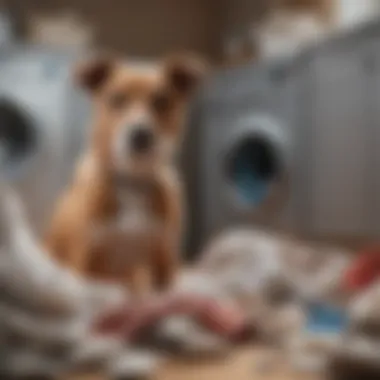Understanding Why Dogs Chew Underwear: Causes and Solutions


Intro
Animal Overview
Common Name and Scientific Classification
The domestic dog, scientifically known as Canis lupus familiaris, is a subspecies of the gray wolf. They were domesticated thousands of years ago, evolving from hunter-gatherers into companions. This history is key to understanding their current behaviors, including chewing.
Physical Characteristics
Dogs come in various shapes and sizes. They have strong jaws, sharp teeth, and a keen sense of smell. These traits allow them to explore their environment. A dog’s breed often influences its underlying behaviors, including chewing tendencies. For instance, breeds like Beagles and Labrador Retrievers may show a heightened interest in fabric due to their working dog background.
Habitat and Distribution
Dogs are found worldwide. They adapt well to different environments, from urban apartments to rural homes. This adaptability showcases their diverse behavior patterns, driven by both instinct and taught experiences.
Behavior and Social Structure
Communication Methods
Dogs communicate through vocalizations, body language, and their sense of smell. Chewing on items like underwear can be a form of communication. It might express stress, boredom, or even an appeal for attention from their owner. Understanding this language is crucial for addressing the action effectively.
Social Hierarchies
Within dog packs, social structures exist. Dogs can recognize their position relative to others, including humans. An anxious or lonely dog might resort to chewing as a coping mechanism, attempting to ease its stress or loneliness.
Mating and Reproductive Behavior
When female dogs are in heat, they may exhibit different behaviors, including increased interest in clothing items. This could be linked to the scents that linger, relating to natural instincts.
Causes for Chewing Underwear
Understanding the reasons for chewing on underwear requires a look at multiple angles. Here are some key factors:
- Instinctual Behavior: Dogs have natural chewing instincts rooted in their ancestral habits.
- Boredom and Lack of Stimulation: Dogs that are not mentally or physically engaged often resort to unwanted behaviors as a means of entertainment.
- Separation Anxiety: Dogs experience emotions. Some may chew underwear as a response to anxiety during their owner’s absence.
- Scent Attraction: Fabric carries scents. Underwear holds the owner's scent, which can be calming or inviting for the dog.
Management Strategies


Effectively managing a dog's habit of chewing underwear involves:
- Training: Reinforce positive behaviors through consistent commands and rewards.
- Environmental Enrichment: Provide toys and activities to reduce boredom.
- Behavioral Intervention: Identify and address the emotional triggers that lead to chewing.
- Avoiding Access: Keep laundry baskets out of reach or use closed hampers to minimize temptation.
By understanding the underlying reasons, pet owners can create a more harmonious environment for their dogs, while also protecting personal items.
As we continue to explore this behavior in detail, we can better equip ourselves with the knowledge necessary for responsible pet ownership.
Intro to Canine Chewing Behavior
Understanding chewing behavior in dogs is essential for responsible pet ownership. It sheds light on the canine psyche, revealing what drives these animals to bite and chew, especially on personal items such as underwear. This section explores the nuances of normal chewing habits and the instinctual nature of this behavior, providing clarity on why dogs engage in such actions.
Understanding Normal Chewing Habits
Chewing is a natural behavior for dogs. Puppies chew to explore their environment, teethe, and relieve discomfort during the teething process. As they grow, this behavior continues. Normal chewing habits can vary among individual dogs. Some may be more prone to chew items like shoes or furniture. Dogs often experience chewing as an effective way to deal with stress or boredom. Recognizing these normal habits allows pet owners to find a balance between acceptable chewing and destructive behavior.
- Factors influencing chewing habits include:
- Age and developmental stage.
- Breed-specific tendencies.
- Environmental factors and training history.
This knowledge can help owners identify what their dogs prefer to chew and why. Consistent observation helps to notice patterns that can inform better management strategies.
Chewing as a Natural Instinct
Chewing is not just a learned behavior; it is deeply rooted in a dog’s natural instinct. The ancestors of modern dogs, such as wolves, chewed on bones and other materials as a way to obtain nutrients and keep their teeth clean. This instinct still persists today, influencing many dogs to seek out specific textures or smells that remind them of these ancestral behaviors.
The appeal of certain fabrics, like underwear, can arise from several factors. The human scent embedded in clothing can attract a dog's attention. Additionally, the soft and varied textures provide a satisfying chewing experience. Understanding that chewing is instinctual helps owners view the behavior from a different perspective rather than merely as a nuisance.
Recognizing that chewing stems from natural instincts can foster empathy and improve owner-dog relationships.
Motivations for Chewing Underwear
Understanding why dogs chew on underwear is essential for pet owners. This behavior can stem from various motivations, which include sensory experiences, emotions, and boredom. By unpacking these motivations, it becomes clearer how to address this issue, allowing for a healthier relationship between pet and owner.
Sensory Appeal of Underwear Fabrics
One significant reason dogs are drawn to chew underwear is the sensory appeal of fabrics. Underwear, typically made from soft materials like cotton, lace, or spandex, can be particularly enticing. The texture may offer comfort to dogs, evoking a sense of security or pleasure as they engage with it. Furthermore, these fabrics often carry unique scents, such as that of the owner. This smell can be soothing and familiar, driving a dog's desire to chew. When encountering found objects that possess these sensory traits, the animal finds it rewarding, much like a toy.


Boredom and Lack of Stimulation
Another prominent factor contributing to dogs chewing underwear is boredom and lack of stimulation. Dogs are naturally energetic creatures and require enough physical and mental engagement to keep them satisfied. When left alone or confined for extended periods, they may seek alternative activities like chewing on household items. Underwear often becomes an easy target as it is usually accessible and readily available. This behavior can signal the need for more structured playtime or interactive toys to fulfill their curiosity and energy demands. Pet owners should be mindful of their dog's activity levels and find suitable replacements to prevent chewing issues.
Separation Anxiety and Comfort Seeking
Canine separation anxiety is a legitimate concern that can also lead to chewing, particularly on personal items like underwear. When dogs feel distress during their owner's absence, they might chew on familiar objects as a form of self-soothing. The scent of their owner on the fabric can provide comfort, helping them cope with the situation. Recognizing this connection allows owners to approach the issue with empathy. Solutions might include providing safe, comforting items for the dog while gradually increasing the time apart, helping them adjust to being alone without reliance on inappropriate items.
Attention-Seeking Behavior
Dogs are adept at understanding responses from their owners. For some, chewing underwear may serve as a strategy for gaining attention, even if it's negative. If a dog notices that chewing elicits a reaction—be it laughter, scolding, or concern—they may be inclined to continue this behavior. It is crucial for pet owners to be aware of this dynamic, as it can reinforce the habit. Instead of reacting to the chewing behavior directly, it's better to redirect the dog's focus towards acceptable toys and activities. Consistent training methods can help diminish attention-seeking chewing, leading to a more harmonious household.
Implications of Chewing Underwear
Understanding the implications of dogs chewing underwear is crucial for several reasons. This behavior can have both physical and social consequences. Ignoring the issues surrounding this chewing habit might lead to further complications for the dog and the household. Addressing these implications can help pet owners take appropriate actions, ensuring a harmonious living environment and maintaining the dog's well-being.
Potential Risks and Health Concerns
Chewing on underwear is not simply an annoying behavior. It poses real risks that can affect a dog's health. The fabric of underwear often comprises materials that can be harmful if ingested. For instance, a dog may accidentally swallow pieces of fabric, leading to gastrointestinal blockages. This situation requires immediate veterinary attention. Symptoms of such blockages include vomiting, lethargy, or a lack of appetite.
Additionally, the detergents and softeners used on underwear may cause allergic reactions or other skin issues when dogs come into contact with them. It is essential for owners to monitor their dogs for any signs of discomfort or irritation. This vigilant approach can prevent long-term health concerns that may arise from habitual chewing.
Chewing can result in more than just behavioral issues; it can lead to significant health complications.
Impact on Household Dynamics
Chewing on underwear also disrupts the household dynamics. This behavior can create tension among family members. For instance, a spouse or child may be unable to understand why their belongings are destroyed. This frustration can lead to conflicts between family members if not managed properly.
When a dog chews on personal items, it may also lead to a negative perception of the dog’s character. People may start to view the dog as problematic or rebellious. This perception, combined with frustration, can result in less positive interactions between the family and the pet. The affection and bond between the dog and the household may suffer if this behavior continues.
To summarize, there are essential considerations to keep in mind concerning the implications of dogs chewing underwear. The potential health risks can affect the dog's physical state, while the impact on household dynamics can strain relationships among family members. Therefore, it is vital for owners to recognize these implications and address them in order to maintain a healthy and harmonious environment.
Training and Management Strategies
Training and management strategies are essential for addressing the behavior of dogs chewing underwear. By understanding these strategies, pet owners can develop more structured approaches to redirect their pets’ behaviors. Implementing appropriate training techniques not only helps in modifying this behavior but also strengthens the bond between the pet and owner. Creating an environment that discourages chewing underwear while fostering positive activities is crucial. The following sections detail ways to effectively manage and train dogs to curb this behavior.
Redirecting Chewing Behavior


Redirecting chewing behavior involves offering dogs alternatives that satisfy their instinctual needs. For dogs, chewing serves various purposes, and providing them with appropriate items can mitigate the urge to chew on underwear. Here are some methods to consider:
- Identify Chewing Triggers: Observe when and why your dog chews underwear. It may happen during moments of boredom, anxiety, or stimuli.
- Offer Appropriate Chew Toys: Invest in high-quality chew toys designed specifically for dogs. These toys should be durable and enticing enough to capture your dog's attention.
- Use Positive Reinforcement: When your dog chooses to chew on the designated toys instead of underwear, reward them with praise or treats. This reinforces the desired behavior.
- **Create a
Long-Term Solutions for Chewing Issues
Addressing the issue of dogs chewing underwear necessitates a strategic, long-term approach. This approach not only addresses the behavior but also enhances the overall well-being of your pet. Understanding that underlying motivations, such as anxiety or boredom, can contribute to this behavior is crucial. By implementing sustainable solutions, pet owners can foster a healthier environment that mitigates these habits over time.
Professional Training and Behavior Modification
Professional training is a valuable avenue for pet owners grappling with their dog's chewing behavior. Engaging a certified dog trainer can provide tailored solutions that cater to the specific needs of both owner and pet. These trainers often utilize positive reinforcement techniques to encourage desired behaviors. This can include rewarding your dog with treats when they opt for appropriate toys over underwear.
Additionally, behavior modification therapies may be employed to address anxiety and stress triggers. Techniques like desensitization, which gradually exposes your dog to sources of anxiety in a controlled manner, can build their resilience. It's important that the training involves consistent and patience. This investment in professional help can lead to significant improvements, offering lasting benefits not just in managing chewing but also in nurturing a stronger bond between you and your dog.
Veterinary Assistance for Anxiety-Related Issues
In some cases, chewing may stem from deeper anxiety-related issues that require medical intervention. Consulting a veterinarian can uncover underlying health problems that could be contributing to your dog's behavior. The veterinarian might assess your dog for conditions like separation anxiety or compulsive behaviors.
If anxiety is confirmed, your vet may recommend treatments ranging from behavioral therapy to medication. Medications used can help stabilize your dog's mood, making it easier for them to engage in training and other activities. This veterinary support is important for achieving long-term solutions, as it deals with the root causes rather than merely addressing symptoms.
Seeking professional and veterinary guidance can transform your approach to your dog's chewing issues.
Ultimately, by focusing on training and proper veterinary support, pet owners can address not only the chewing behavior but also improve their dog’s overall quality of life. With time, dedication, and appropriate interventions, the challenges associated with chewing can transition into a well-managed aspect of pet ownership.
Closure and Recommendations
Understanding Your Dog's Needs
Dogs display chewing behaviors for various reasons, and it is essential to understand these motivations fully. Whether driven by instinct, anxiety, or boredom, each need must be addressed appropriately. Here are some important considerations:
- Instinctual Preferences: Dogs have a natural tendency to chew. They explore their environment through their mouths, and certain fabrics, like those in underwear, may simply appeal to their sensory instincts.
- Emotional Well-being: A dog may chew underwear as a coping mechanism for anxiety or stress. Understanding your dog's emotional triggers can help manage their behavior effectively.
- Daily Activity Needs: Dogs require mental stimulation and physical exercise. A lack of these can lead to destructive behaviors, including chewing on unwanted items.
Identifying and responding to these needs is imperative. It not only prevents unwanted chewing but also enhances the overall quality of life for both the dog and the owner.
The Role of Responsible Pet Ownership
Responsible pet ownership plays a significant part in solving the issue of dogs chewing underwear. Here are some essential practices for pet owners:
- Provide Appropriate Toys: Ensure that your dog has access to suitable chew toys that are safe and engaging. This can help redirect their chewing behavior to appropriate items, which minimizes the temptation to chew on underwear.
- Regular Physical and Mental Activities: Incorporate regular walks, playtime, and interactive games into your dog's routine. Activities that challenge them mentally can reduce boredom and its associated behaviors.
- Seek Professional Guidance: If chewing persists, consider seeking help from a professional trainer or veterinarian. They can provide tailored advice based on your dog's specific needs.
“Understanding a dog’s behavior is a vital component of successful companionship.”
By engaging with your dog’s needs and employing responsible ownership practices, owners can significantly decrease the likelihood of unwanted chewing behaviors. This not only safeguards household items but also contributes to a well-balanced and happy dog. In the end, informed actions can yield meaningful benefits for both pets and their owners.







